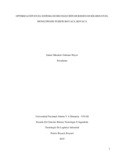Mostrar el registro sencillo del ítem
Optimización en el sistema de recolección de residuos sólidos en el municipio de Puerto Boyacá, Boyacá
| dc.contributor.advisor | MARTHA CATALINA OSPINA HERNÁNDEZ | |
| dc.coverage.spatial | cead_-_la_dorada | |
| dc.creator | GALEANO HOYOS, JANNER MAURICIO | |
| dc.date.accessioned | 2020-11-17T16:01:12Z | |
| dc.date.available | 2020-11-17T16:01:12Z | |
| dc.date.created | 2019-09-03 | |
| dc.identifier.uri | https://repository.unad.edu.co/handle/10596/37457 | |
| dc.description | Anexos Anexo 1. Ruteo optimizado lunes y jueves Anexo 2. Ruteo optimizado martes y viernes Anexo 3. Ruteo optimizado miércoles y sábado Anexo 4. Indicadores relevantes de mantenimiento Anexo 5. Chipeadora Anexo 6. Cronograma de capacitaciones | |
| dc.description.abstract | La aparición de la especie humana ha traído consigo una serie de cambios para el entorno, debido a los métodos de supervivencia que ha empleado, y con ello, ha dado lugar a la generación de bazofias que se constituyen como un elemento perturbador y/o dañino para el bienestar y desarrollo del ser humano y su medio. El deterioro ambiental es producto del manejo inadecuado y el abuso que ha cometido el hombre contra la naturaleza, cabe resaltar “la basura no es nueva, nace con el hombre”. Partiendo de esa premisa se puede inferir que; es el ser humano el único responsable de la decadencia que está presentando la Tierra, el calentamiento global, fenómeno que no sólo afecta la especie humana sino también, la vegetal y animal. Todo lo anterior, es producto de las rebuscallas compactas derivadas de las acciones humanas. El presente trabajo de grado propone una actuación planificada, coordenada, sistemática a mayor cantidad de residuos sólidos recolectados y menor tiempo de recolección de los mismos; donde se aborda diferentes actividades encaminadas a generar una propuesta que permita mejorar la cobertura del servicio de recolección de basuras, el bienestar de la comunidad, y a la prevención de proliferación de insectos, roedores, ocasionados por la acumulación de basura, empleando para ello, el algoritmo de la ruta más corta, encuestas, y una serie de herramientas que permita el ruteo en el área urbana de una manera más adecuada. Palabras claves: Residuos sólidos, rutas, tiempos, y optimización. | |
| dc.format | ||
| dc.title | Optimización en el sistema de recolección de residuos sólidos en el municipio de Puerto Boyacá, Boyacá | spa |
| dc.type | Proyecto aplicado | |
| dc.subject.keywords | Residuos sólidos | spa |
| dc.subject.keywords | Recolección de basuras | spa |
| dc.description.abstractenglish | The appearance of the human species has brought with it a series of changes for the environment, due to the survival methods it has used, and with this, it has led to the generation of slops that constitute a disturbing element and / or harmful to the well-being and development of human beings and their environment. Environmental deterioration is the product of improper handling and abuse that man has committed against nature, it should be noted "garbage is not new, it is born with man." Starting from this premise it can be inferred that; It is the human being who is solely responsible for the decline that the Earth is presenting, global warming, a phenomenon that not only affects the human species but also the plant and animal species. All of the above is the product of compact gimmicks derived from human actions. The present work of degree proposes a planned, coordinated, systematic action to greater quantity of collected solid waste and less time of collection of the same; which addresses different activities aimed at generating a proposal that allows improving the coverage of the garbage collection service, the well-being of the community, and the prevention of the proliferation of insects, rodents, caused by the accumulation of garbage, using for this, the algorithm of the shortest route, surveys, and a series of tools that allow routing in the urban area in a more adequate way. Keywords: Solid waste, routes, times, and optimization. | |
| dc.subject.category | logística de distribución | |
| dc.subject.category | reducción de tiempos | |
| dc.subject.category | aprovisionamiento | |
| dc.subject.category | programación lineal | |
| dc.subject.category | ruteo |















